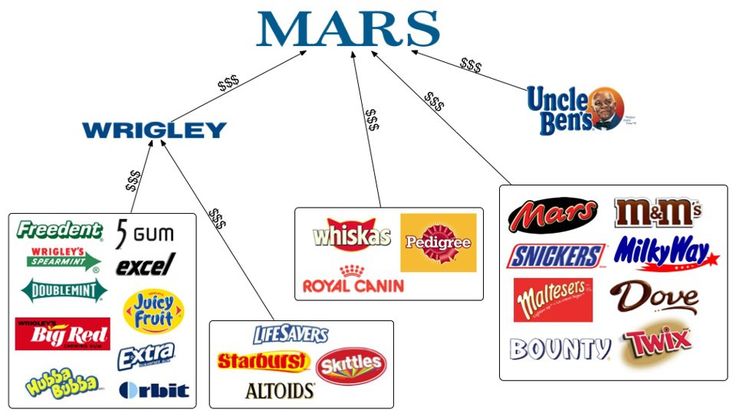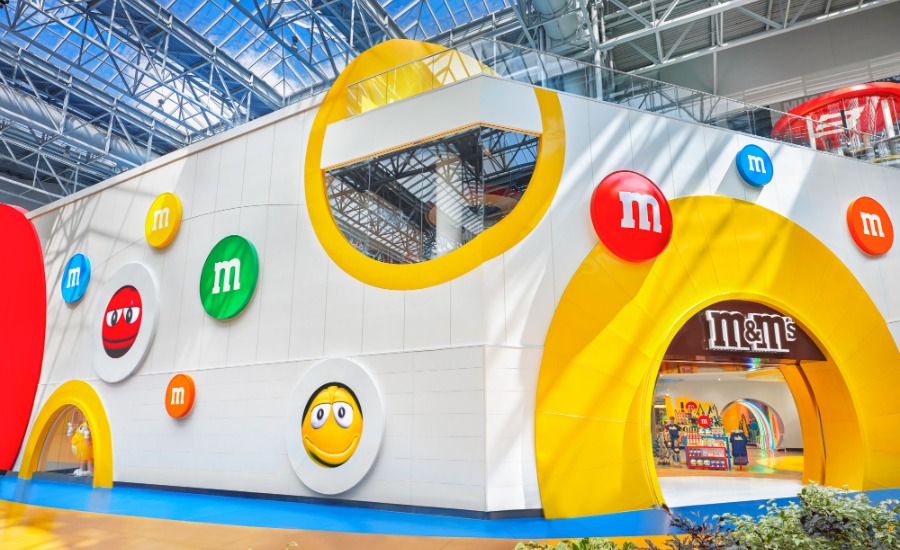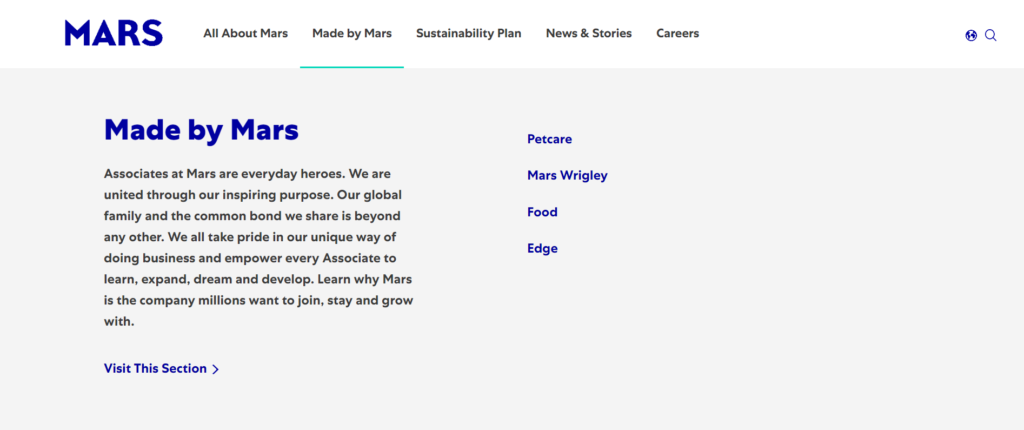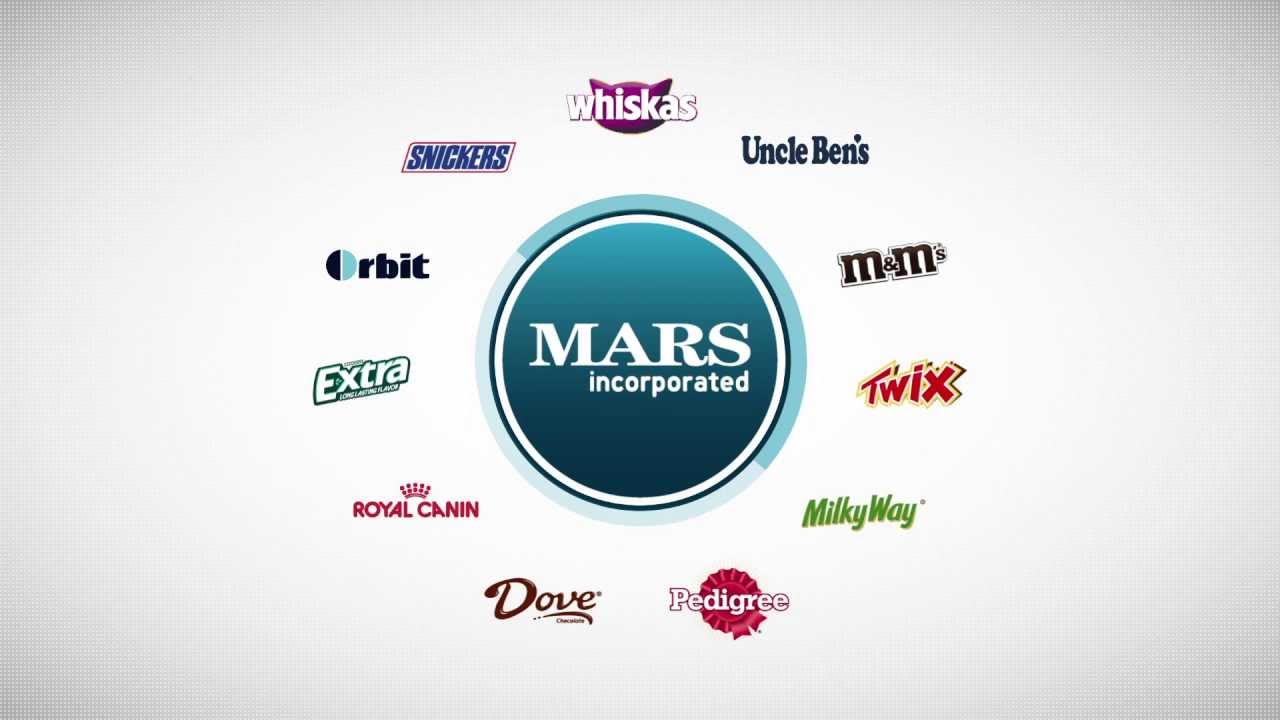Mars, Incorporated is an American multinational manufacturer of confectionery, pet food, and other food products and a provider of animal care services. It was founded in 1911 by Frank C. Mars and is still owned by the Mars family. Mars is headquartered in McLean, Virginia, and has operations in over 80 countries.

Mars is known for its popular brands of confectionery, including M&M’s, Snickers, Twix, Milky Way, and Mars bars. It also produces non-confectionery snacks, such as Combos, and other foods, including Ben’s Original and Dolmio pasta sauce brands. In addition, Mars owns several pet food brands, including Pedigree, Whiskas, Nutro, and Royal Canin.
Mars is a leading provider of animal care services through its VCA Inc. subsidiary, which operates over 800 veterinary hospitals in the United States and Canada. Mars also owns Banfield Pet Hospital, a chain of veterinary clinics that offers preventive care services.
Mars is a privately held company, so its financial results are not publicly available. However, it is estimated that Mars generates over $45 billion in annual sales. Mars is one of the largest food companies in the world and employs over 133,000 people globally. Mars is also a major supporter of charitable causes, including the Mars Wounded Veterans Program and the Mars Petcare Global Animal Shelter Program.
Mars conducts its global operations through four distinct business segments. These segments include Mars Wrigley Confectionery, with its main office in Chicago, Illinois, and U.S. offices in Hackettstown and Newark, New Jersey. Additionally, there is the Petcare segment, which operates from locations in Zaventem, Belgium, as well as Poncitlán and Jalisco, Mexico, and Querétaro, Mexico. The Food segment is based in Rancho Dominguez, California, while MARS Edge, the company’s life sciences division, is situated in Germantown, Maryland.
Marketing Strategies of Mars
ars Incorporated, a global conglomerate known for its wide range of consumer goods, including confectionery, pet care, food products, and more, employs several marketing strategies to maintain its competitive edge and reach consumers effectively. Here’s a detailed explanation of some of their key marketing strategies:
1. Product Portfolio Diversification
Product portfolio diversification involves offering a range of products to meet different customer needs and preferences. Here are some examples of how Mars uses product portfolio diversification as a marketing strategy:

Chocolate segment: Mars sells various types of chocolate bars under brands such as M&M’s, Snickers, Twix, Milky Way, and more. Each bar caters to distinct taste profiles, textures, and dietary requirements, allowing consumers to choose the perfect treat for any occasion or mood.
Petcare segment: Mars operates pet food and treats lines under brands like Pedigree, Whiskas, Royal Canin, and Banfield Pet Hospital. With options for dogs, cats, birds, fish, and small animals, Mars provides comprehensive solutions for animal lovers seeking high-quality nutrition and care for their pets.
Food segment: Mars owns well-known brands like Uncle Ben’s, Seeds of Change, Dolmio, and Ebly, offering diverse ranges of rice, pasta sauce, meal kits, and snacks. These products appeal to health-conscious individuals looking for convenient, flavorful, and wholesome choices.
Drinks segment: Mars manufactures beverages under labels like Starburst, Skittles, Juicy Fruit, and Life Savers, providing refreshing alternatives for people with varying sweetness preferences and consumption occasions.
Symbioscience segment: Mars conducts research and development in areas like human health, plant science, and life sciences, exploring innovative applications for its expertise in agriculture, nutrition, and biotechnology. While this division may not directly contribute to Mars’ marketable products, it demonstrates the company’s commitment to advancing knowledge and addressing global challenges, potentially enhancing overall brand image and reputation.
2. Brand Building
Brand building refers to the process of developing a strong identity and reputation for a product or service through consistent messaging, imagery, and overall positioning within the marketplace. For Mars Inc., brand building is critical given the highly competitive nature of the food and confectionery industries. To achieve this goal, Mars can employ various tactics including:
Consistent Messaging: Developing clear and concise messaging that reflects the values and mission of the company is essential for establishing a strong brand identity. This messaging should be consistently applied across all channels, including packaging, advertising, public relations, and social media.

Iconic Packaging Design: The distinctive red and yellow M&M’s package is instantly recognizable and contributes significantly to the brand’s iconic status. Other Mars brands like Snickers, Skittles, and Twix also feature memorable packaging designs that help differentiate them from competitors.
Emotionally Compelling Advertising: Mars creates emotionally resonant advertising campaigns that capture people’s hearts and minds. For example, the “You’re Not You When You’re Hungry” campaign for Snickers features celebrities playing exaggerated versions of themselves when hungry versus well-fed. This approach taps into universal emotional truths and reinforces the idea that Snickers satisfies hunger in a funny and relatable way.
Sponsorship and Partnerships: Mars partners with high-profile sports teams, athletes, and entertainment properties to align its brands with positive associations and increase visibility. For example, M&M’s sponsored the Super Bowl halftime show featuring Shakira and Jennifer Lopez, providing millions of viewers with a tasteful and family-friendly experience that aligned with the brand’s wholesome image.
3. Innovation and Product Development
As one of the world’s leading chocolate manufacturers, Mars has long recognized the importance of innovation and product development in driving business success. By continually creating new and exciting offerings, the company can attract and retain customers while expanding its presence in global markets.
One notable example of Mars’ commitment to innovation is its recent introduction of the “Snackable Chocolate Bites” line under the Dove brand. These bite-size pieces of premium dark chocolate cater to consumers seeking convenient indulgences without compromising on taste or quality. Through targeted marketing efforts, Mars effectively communicated the unique benefits of Snackable Chocolate Bites to key audiences, resulting in significant sales increases and increased brand awareness.
Another crucial aspect of Mars’ innovation strategy is its focus on sustainability and responsible sourcing practices. As consumers become increasingly conscious of environmental impacts and ethical considerations, companies must demonstrate their commitment to making a positive difference. Mars has taken steps towards using certified sustainable ingredients, reducing carbon footprints, and supporting smallholder farmer livelihoods – all factors that contribute positively to its corporate reputation and appeal to socially conscious customers.
Overall, Mars leverages innovation and product development as a core component of its marketing strategy by identifying customer preferences, responding to changing industry dynamics, and fostering a culture of continuous improvement. By doing so, it positions itself as a forward-thinking organization that delivers exceptional experiences to both internal and external stakeholders alike.
4. Digital Marketing
Digital marketing plays a critical role in Mars Inc.’s marketing strategy, allowing the company to reach and engage with customers through various digital channels. Here are some examples of how Mars uses digital marketing to achieve its goals:
Website Optimization: Mars maintains well-designed, mobile-friendly websites for each of its major brands, providing detailed information about products, nutrition facts, recipes, and other useful content. The sites often feature interactive elements like quizzes, games, and virtual tours, keeping visitors engaged and entertained.

Social Media Engagement: Mars actively manages several social media accounts across popular platforms such as Facebook, Instagram, Twitter, LinkedIn, etc. The company shares visually appealing posts showcasing its products, behind-the-scenes glimpses of factory operations, employee stories, community initiatives, and more. Mars also interacts with followers by responding to comments, answering questions, and joining conversations related to its industries.
Video Content Creation: Mars produces high-quality video ads, tutorials, documentaries, and influencer collaborations to captivate viewers and convey brand messages. These videos may highlight product features, tell inspiring stories, share cooking tips, or explore topics related to sustainability, science, and technology.
Email Marketing Campaigns: Mars sends personalized emails to subscribers, offering exclusive deals, promoting new releases, sharing newsletters, and soliciting feedback. These email blasts often include eye-catching graphics, clear calls-to-action, and easy unsubscribe options to ensure optimal user experience.
Online Advertising: Mars invests in paid digital advertising placements, including display banners, retargeting ads, programmatic buys, native ads, and sponsored content. These ads appear on popular websites, apps, and social media feeds, reaching potential customers at various stages of the purchasing journey. Mars carefully targets its audience based on demographics, interests, behaviors, and device usage to maximize ROI and minimize wasted impressions.
5. Retail Partnerships
Retail partnerships play an essential role in Mars Inc.’s overall marketing strategy. By forming alliances with leading retail chains, Mars can expand its distribution networks, increase brand exposure, and tap into existing customer bases. Here are some ways that Mars leverages retail partnerships as part of its marketing plan:
Shelf Space Negotiations: Mars negotiates favorable shelf space agreements with retailers, ensuring prime locations within stores for its products. This increased visibility helps attract attention from consumers and encourages impulse purchases.

Product Placement: Mars works with retailers to determine ideal product placement within stores, taking into account factors like category adjacencies, shopper behavior patterns, and competitive dynamics. Proper positioning can improve sales and strengthen brand recognition among shoppers.
Co-Branding Opportunities: Mars collaborates with retail partners to co-brand products, packaging, displays, and promotional materials. Such joint ventures help reinforce both parties’ images while creating unique selling propositions that differentiate offerings from competitors’.
Exclusive Promotions: Mars creates exclusive promotions and discounts tailored specifically for partner retailers. These limited-time deals encourage customers to make purchases during those periods, generating additional revenue streams for both Mars and its retail partners.
Cross-Promotion Activities: Mars participates in cross-promotion campaigns alongside retail partners, combining forces to run integrated marketing programs. Joint advertisements, social media contests, and experiential events can generate buzz around shared objectives and benefit all involved parties.
6. Partnerships and Sponsorships
partnerships and sponsorships constitute another vital aspect of Mars Inc.’s marketing strategy. Through these arrangements, Mars can leverage complementary brands, reach broader audiences, showcase its commitment to specific causes, and enhance its reputation as a responsible corporate citizen. Some examples of Mars’ partnership and sponsorship initiatives include:
Cause-Related Alliances: Mars forms partnerships with organizations focused on issues relevant to its core values, such as environmental conservation, animal welfare, and community development. For instance, it has teamed up with the Rainforest Alliance, World Wildlife Fund, and National Geographic Society to promote sustainability and biodiversity preservation.
Event Collaborations: Mars supports high-profile events, festivals, and conferences through sponsorships and participation. These opportunities allow Mars to associate itself with popular cultural happenings, gain exposure to target demographics, and demonstrate support for local communities.
Influencer Endorsements: Mars enlists influencers across various industries, including entertainment, sports, fashion, and lifestyle, to endorse its products and share positive experiences with their followers. These partnerships not only amplify brand awareness but also humanize Mars’ image by connecting it with relatable personalities admired by consumers.
In summary, Mars Incorporated employs a comprehensive marketing strategy that includes diversification, brand building, innovation, global reach, sustainability, digital marketing, retail partnerships, consumer engagement, CSR, market research, and strategic partnerships. This multifaceted approach allows them to adapt to changing consumer preferences and maintain a strong market presence in various industries.
Marketing Mix of Mars Inc.
The marketing mix, often referred to as the 4Ps (Product, Price, Place, Promotion), is a fundamental framework used by companies like Mars Incorporated to develop and implement their marketing strategies effectively. Here’s a detailed explanation of the marketing mix for Mars Inc.:
Product
-
- Product Diversification: Mars offers a wide range of products across various categories, including confectionery (e.g., M&M’s, Snickers), pet care (e.g., Pedigree, Whiskas), and food (e.g., Uncle Ben’s, Dolmio). Their product portfolio includes both well-established brands and newer innovations.
- Quality and Innovation: Mars focuses on product quality and continuous innovation. They invest in research and development to create new flavors, variants, and packaging options to meet evolving consumer preferences. For instance, they may introduce limited-edition flavors or packaging designs for their confectionery products.
- Sustainability: In recent years, Mars has been placing an increased emphasis on sustainability. This includes sourcing sustainable ingredients, reducing their environmental footprint, and making their products more environmentally friendly, which can be considered a product feature in its marketing strategy.
Price
-
- Pricing Strategies: Mars employs various pricing strategies depending on the product category and market conditions. They may use premium pricing for high-quality chocolates like Dove, while adopting competitive pricing for products like pet food.
- Promotions and Discounts: Mars often runs promotions and discounts, especially during seasonal events like Halloween or Christmas, to boost sales. They may also offer volume discounts for bulk purchases, catering to both retail and wholesale customers.
- Value Perception: Mars aims to maintain a balance between price and product quality to create a favorable value perception among consumers. They want customers to feel that they are getting good value for their money.
Place (Distribution)
-
- Global Presence: Mars operates globally, and their products are distributed in numerous countries through a wide range of distribution channels, including supermarkets, convenience stores, online retailers, and pet specialty stores.
- Channel Partnerships: Mars collaborates with retailers and distributors to ensure their products are readily available to consumers. They work closely with these partners to optimize shelf space, placement, and visibility.
- Logistics and Supply Chain: Mars places a strong emphasis on an efficient supply chain to ensure that products are delivered to retailers and customers on time. This includes inventory management, transportation, and warehousing.
Promotion
-
- Advertising: Mars invests heavily in advertising to promote its products. They use various media channels, including TV, print, radio, and digital advertising, to reach their target audience. Iconic campaigns like the M&M’s characters or Snickers’ “You’re Not You When You’re Hungry” have been memorable and effective.
- Digital Marketing: Mars uses digital marketing strategies such as social media advertising, content marketing, email marketing, and influencer partnerships to engage with consumers. They leverage data analytics to target specific demographics effectively.
- Sponsorships and Events: Mars sponsors events and partnerships to increase brand visibility. For example, they may sponsor sports events, which align with their target audience and brand values.
- Corporate Social Responsibility (CSR): Mars promotes its CSR initiatives as part of its promotional efforts. They communicate their commitment to sustainability, responsible sourcing, and community engagement to build a positive brand image.
In summary, Mars Incorporated’s marketing mix involves a diversified product portfolio, competitive pricing strategies, a global distribution network, and a comprehensive promotional approach that includes advertising, digital marketing, sponsorships, and CSR initiatives. This mix enables Mars to effectively reach and engage with its target customers across different product categories and markets.
Also Read: Exploring Marketing Strategies and Marketing Mix of M&M’s
To read more content like this, subscribe to our newsletter



